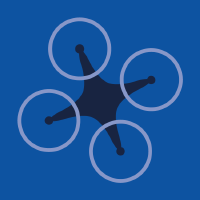Topic Menu
► Topic MenuTopic Editors





Design, Simulation and New Applications of Unmanned Aerial Vehicles
Topic Information
Dear Colleagues,
As the Editor of the Special Issue “Design, Simulation and New Applications of Unmanned Aerial Vehicles”, I would like to invite you to submit a paper on this subject. Recently, we have experienced a huge increase in the development of unmanned aerial vehicles (UAVs). Every month brings new scientific papers pertaining to UAVs, which have become an even stronger accelerator for research in this field. This Special Issue aims to contribute to the development of unmanned aerial vehicles in many areas. Particular attention will be given to high-quality papers that address significant advances in the design, modeling, and control of UAVs, as well as novel applications. Potential topics include, but are not limited to, the following:
- UAV design;
- CAx systems in UAV design;
- Efficiency of UAV platform;
- FEA in UAV design;
- CFD analysis of UAV;
- Fiber composites in UAV;
- MEMS in UAS;
- Sensors in UAV;
- UGV and UAV collaboration;
- Multirotor UAV;
- UAV navigation;
- Machine learning for UAV autonomous control;
- UAV dynamics, control and simulation;
- New applications for UAVs;
- Embedded systems design for UAVs;
- UAS electronics design;
- Algorithms and software for UAV/UAS.
Dr. Andrzej Łukaszewicz
Prof. Dr. Wojciech Giernacki
Prof. Dr. Zbigniew Kulesza
Prof. Dr. Jaroslaw Alexander Pytka
Dr. Andriy Holovatyy
Topic Editors
Keywords
- UAV design
- UAV airframe
- UAV strength analysis
- CAx systems in UAV design
- efficiency of UAV platform
- FEA in UAV design
- CFD analysis of UAV
- smart materials in UAV
- fiber composites in UAV
- MEMS in UAS
- sensors in UAV
- UGV and UAV collaboration
- multirotor UAV
- UAV navigation
- dynamics of UAVs
- machine learning for UAV autonomous control
- UAV control and simulation
- new application for UAVs
- MEMS sensors design for UAVs
- embedded systems design for UAVs
- UAS electronics design
- algorithms and software for UAV/UAS
Participating Journals
| Journal Name | Impact Factor | CiteScore | Launched Year | First Decision (median) | APC |
|---|---|---|---|---|---|

Applied Sciences
|
2.7 | 4.5 | 2011 | 16.9 Days | CHF 2400 |

Drones
|
4.8 | 6.1 | 2017 | 17.9 Days | CHF 2600 |

Energies
|
3.2 | 5.5 | 2008 | 16.1 Days | CHF 2600 |

Machines
|
2.6 | 2.1 | 2013 | 15.6 Days | CHF 2400 |

Materials
|
3.4 | 5.2 | 2008 | 13.9 Days | CHF 2600 |

Sensors
|
3.9 | 6.8 | 2001 | 17 Days | CHF 2600 |

MDPI Topics is cooperating with Preprints.org and has built a direct connection between MDPI journals and Preprints.org. Authors are encouraged to enjoy the benefits by posting a preprint at Preprints.org prior to publication:
- Immediately share your ideas ahead of publication and establish your research priority;
- Protect your idea from being stolen with this time-stamped preprint article;
- Enhance the exposure and impact of your research;
- Receive feedback from your peers in advance;
- Have it indexed in Web of Science (Preprint Citation Index), Google Scholar, Crossref, SHARE, PrePubMed, Scilit and Europe PMC.

